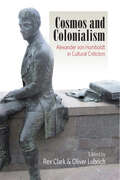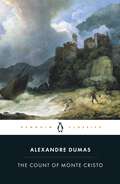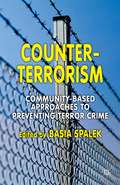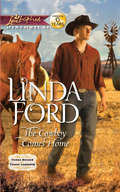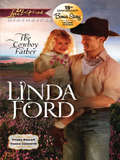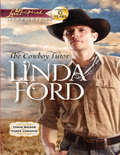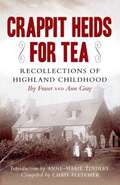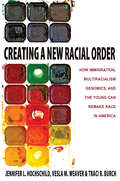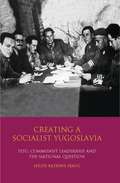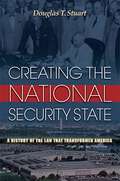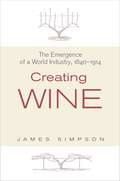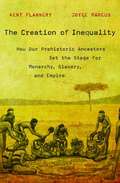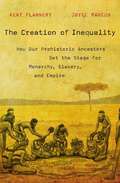- Table View
- List View
Cosmos and Colonialism: Alexander von Humboldt in Cultural Criticism (Berghahn Ser.)
by Rex Clark Oliver LubrichAlexander von Humboldt explored the Spanish Empire on the verge of its collapse (1799–1804). He is the most significant German travel writer and the most important mediator between Europe and the Americas of the nineteenth century. His works integrated knowledge from two dozen domains. Today, he is at the center of debates on imperial discourse, postcolonialism, and globalization. This collection of fifty essays brings together a range of responses, many presented here for the first time in English. Authors from Schiller, Chateaubriand, Sarmiento, and Nietzsche, to Robert Musil, Kurt Tucholsky, Ernst Bloch, and Alejo Carpentier paint the historical background. Essays by contemporary travel writers and recent critics outline the current controversies on Humboldt. The source materials collected here will be indispensable to scholars of German, French, and Latin and North American literature as well as cultural and postcolonial studies, history, art history, and the history of science.
The Count of Monte Cristo: In English Translation
by Alexandre DumasThe epic tale of wrongful imprisonment, adventure and revenge, in its definitive translationThrown in prison for a crime he has not committed, Edmond Dantès is confined to the grim fortress of If. There he learns of a great hoard of treasure hidden on the Isle of Monte Cristo and he becomes determined not only to escape, but also to use the treasure to plot the destruction of the three men responsible for his incarceration. Dumas' epic tale of suffering and retribution, inspired by a real-life case of wrongful imprisonment, was a huge popular success when it was first serialized in the 1840s.Translated with an Introduction by ROBIN BUSS
Counter-Terrorism: Community-Based Approaches to Preventing Terror Crime
by B. SpalekThis book examines community-based approaches to counter-terrorism through an analysis of the notions of community, partnership, engagement, gender and religion in order to shed new light on the potential of, and drawbacks to these approaches. Dr. Spalek stresses the need for policy makers and practitioners to reflect on the effectiveness of the initiatives that they are engaged with, particularly in relation to how community-targeted or community-focused they are.
A Court Affair
by Emily PurdyPassion, Treachery, Betrayal. The virgin queen has arrived… Uncovering the love triangle between Queen Elizabeth I, Robert Dudley, and his wife Amy, and her mysterious death,A Court Affair is an unforgettable story of ambition, lust and jealousy.
Court Politics and the Earl of Essex, 1589–1601 (Political and Popular Culture in the Early Modern Period)
by Janet DickinsonThe 1590s have long been considered as having had a distinct character, separate from the remainder of Elizabeth’s reign. This book provides a reassessment of the politics and political culture of this significant period.
Court Politics and the Earl of Essex, 1589–1601 (Political and Popular Culture in the Early Modern Period #6)
by Janet DickinsonThe 1590s have long been considered as having had a distinct character, separate from the remainder of Elizabeth’s reign. This book provides a reassessment of the politics and political culture of this significant period.
Courtly Encounters: Translating Courtliness And Violence In Early Modern Eurasia (Mary Flexner Lectures Of Bryn Mawr College Ser. #2)
by Sanjay SubrahmanyamIn the sixteenth and seventeenth centuries the court was the crucial site where expanding Eurasian states and empires met and made sense of one another. Richly illustrated, Courtly Encounters provides a fresh cross-cultural perspective on early modern Islam, Counter-Reformation Catholicism, Protestantism, and a newly emergent Hindu sphere.
Courtly Encounters: Translating Courtliness And Violence In Early Modern Eurasia (Mary Flexner Lectures Of Bryn Mawr College Ser. #2)
by Sanjay SubrahmanyamIn the sixteenth and seventeenth centuries the court was the crucial site where expanding Eurasian states and empires met and made sense of one another. Richly illustrated, Courtly Encounters provides a fresh cross-cultural perspective on early modern Islam, Counter-Reformation Catholicism, Protestantism, and a newly emergent Hindu sphere.
Courtship and Marriage in Victorian England (Victorian Life and Times)
by Jennifer PhegleyThis book examines the popular publications of the Victorian period, illuminating the intricacies of courtship and marriage from the differing perspectives of the working, middle, and upper classes.In contemporary culture, the near obsessive pursuit of love and monogamous bliss is considered "normal," as evidenced by a wide range of online dating sites, television shows such as Sex in the City and The Bachelorette, and an endless stream of Hollywood romantic comedies. Ironically, when it comes to love and marriage, we still wrestle with many of the same emotional and social challenges as our 19th-century predecessors did over 100 years ago.Courtship and Marriage in Victorian England draws on little-known conduct books, letter-writing manuals, domestic guidebooks, periodical articles, letters, and novels to reveal what the period equivalents of "dating" and "tying the knot" were like in the Victorian era. By addressing topics such as the etiquette of introductions and home visits, the roles of parents and chaperones, the events of the London season, model love letters, and the specific challenges facing domestic servants seeking spouses, author Jennifer Phegley provides a fascinating examination of British courtship and marriage rituals among the working, middle, and upper classes from the 1830s to the 1910s.
Courtship and Marriage in Victorian England (Victorian Life and Times)
by Jennifer PhegleyThis book examines the popular publications of the Victorian period, illuminating the intricacies of courtship and marriage from the differing perspectives of the working, middle, and upper classes.In contemporary culture, the near obsessive pursuit of love and monogamous bliss is considered "normal," as evidenced by a wide range of online dating sites, television shows such as Sex in the City and The Bachelorette, and an endless stream of Hollywood romantic comedies. Ironically, when it comes to love and marriage, we still wrestle with many of the same emotional and social challenges as our 19th-century predecessors did over 100 years ago.Courtship and Marriage in Victorian England draws on little-known conduct books, letter-writing manuals, domestic guidebooks, periodical articles, letters, and novels to reveal what the period equivalents of "dating" and "tying the knot" were like in the Victorian era. By addressing topics such as the etiquette of introductions and home visits, the roles of parents and chaperones, the events of the London season, model love letters, and the specific challenges facing domestic servants seeking spouses, author Jennifer Phegley provides a fascinating examination of British courtship and marriage rituals among the working, middle, and upper classes from the 1830s to the 1910s.
The Cowboy Comes Home: The Cowboy Tutor The Cowboy Father The Cowboy Comes Home (Mills And Boon Love Inspired Historical Ser.)
by Linda FordNEXT DOOR TO LOVE
The Cowboy Father (Mills And Boon Love Inspired Historical Ser.)
by Linda FordWith Alberta in the grip of the Depression, Louisa Morgan is desperate to bolster her family's finances.
The Cowboy Tutor: The Cowboy Tutor The Cowboy Father The Cowboy Comes Home (Three Brides for Three Cowboys #1)
by Linda FordLesson One: Listen To Your Heart
A Cowboy Worth Claiming (The Worths of Red Ridge #3)
by Charlene SandsCowboy Chance Worth gets more than he bargains for when he saves damsel in distress Lizzie Mitchell. He has come to Red Ridge, Arizona, to rescue her family's failing ranch and find Lizzie a suitable husband. Too bad it wouldn't be honorable to keep the little spitfire for himself!
Cox's Fragmenta II: Further Folios from History
by Simon MurphyA presumptuous bear imposing on a coachful of ladies, how to behave in the British Museum, the dangers of dallying with a black-eyed girl and the Royal Navy’s inaugural biscuit machine are just some of the masterpieces of understated journalism collected by Francis Cox and contained in his Fragmenta. At ninety-four volumes, Cox’s scrapbook has to be one of the largest collections of journalistic ephemera ever. For sixty years during the late eighteenth and early nineteenth centuries he accumulated articles on everything from duels to playhouses, and foreign travel to warfare. Following on from the success of the first volume, Simon Murphy has selected more bizarre stories to create another delightful historical miscellany which will intrigue and amuse.
Crappit Heids for Tea: Recollections of a Highland Childhood
by Anne TindleySutherland is one of the most ruggedly beautiful and sparsely populated parts of Scotland. In the nineteenth century, the Duke of Sutherland set about improving his landholdings to make them more productive by building lodges for sporting tenants who came to enjoy the summer fishing and shooting grouse and deer. In the 1870s some 3,000 acres of land were reclaimed at Shinness. A lodge was built there in 1882 and allocated some 2,500 acres of moorland for grouse and grazing, together with the fishings on Loch Shin and its rivers. One of the first keepers at the estate was John Fraser. His daughter, Iby, became a teacher at Lairg School. In the 1970s, long after the Fletcher family had taken on Shinness Estate, Iby wrote down some recollections of her early life for Mrs Fletcher's interest.
Creating a New Racial Order: How Immigration, Multiracialism, Genomics, and the Young Can Remake Race in America (PDF)
by Jennifer L. Hochschild Vesla M. Weaver Traci R. BurchThe American racial order--the beliefs, institutions, and practices that organize relationships among the nation's races and ethnicities--is undergoing its greatest transformation since the 1960s. Creating a New Racial Order takes a groundbreaking look at the reasons behind this dramatic change, and considers how different groups of Americans are being affected. Through revealing narrative and striking research, the authors show that the personal and political choices of Americans will be critical to how, and how much, racial hierarchy is redefined in decades to come. The authors outline the components that make up a racial order and examine the specific mechanisms influencing group dynamics in the United States: immigration, multiracialism, genomic science, and generational change. Cumulatively, these mechanisms increase heterogeneity within each racial or ethnic group, and decrease the distance separating groups from each other. The authors show that individuals are moving across group boundaries, that genomic science is challenging the whole concept of race, and that economic variation within groups is increasing. Above all, young adults understand and practice race differently from their elders: their formative memories are 9/11, Hurricane Katrina, and Obama's election--not civil rights marches, riots, or the early stages of immigration. Blockages could stymie or distort these changes, however, so the authors point to essential policy and political choices. Portraying a vision, not of a postracial America, but of a different racial America, Creating a New Racial Order examines how the structures of race and ethnicity are altering a nation.
Creating a Socialist Yugoslavia: Tito, Communist Leadership and the National Question (International Library of Twentieth Century History)
by Hilde Katrine HaugThe Yugoslav communist leaders aspired to create a socialist Yugoslavia, and when they came into power in 1945, they claimed to have introduced a socialist solution to the Yugoslav national question. But what did it imply to 'solve a national question' and what did introducing a 'socialist solution' to a national question entail? 'Creating a Socialist Yugoslavia: Tito, Communist Leadership and the National Question' charts how the Yugoslav Communist leaders approached the national question, and what influence the complex national relations in the multinational state of Yugoslavia had on the development of the Yugoslav communists' policies, and on their post-war socialist project. From 1935 to 1990, tremendous changes took place in the Yugoslav approach to the national question, and in the institutions they devised as part of this solution. There were also significant changes to the role of the republics and the relations between the different national groups within the Yugoslav state. Discussions on the national question were not absent during this period, despite the communists claim to have solved it. Debates over what kind of Yugoslav unity was the most desirable continued to be a question of contention and different groups had different visions of this. A struggle over resources also developed between different republics. This book identifies and examines four particular phases in the communists' strategies towards the national question; each marked by particular processes, issues and challenges. The claim to have solved the national question often meant that this issue could not be discussed openly and had to be expressed in a particular rhetoric approved by the Party. 'Creating a Socialist Yugoslavia' provides an authoritative account of the Yugoslav communist leaders' national policy and attempts to deal with the challenges encountered by the communists in reconciling their aspiration to create a socialist Yugoslavia with the need to regulate national conflict within the federation.
Creating the National Security State: A History of the Law That Transformed America (PDF)
by Douglas T. StuartFor the last sixty years, American foreign and defense policymaking has been dominated by a network of institutions created by one piece of legislation--the 1947 National Security Act. This is the definitive study of the intense political and bureaucratic struggles that surrounded the passage and initial implementation of the law. Focusing on the critical years from 1937 to 1960, Douglas Stuart shows how disputes over the lessons of Pearl Harbor and World War II informed the debates that culminated in the legislation, and how the new national security agencies were subsequently transformed by battles over missions, budgets, and influence during the early cold war. Stuart provides an in-depth account of the fight over Truman's plan for unification of the armed services, demonstrating how this dispute colored debates about institutional reform. He traces the rise of the Office of the Secretary of Defense, the transformation of the CIA, and the institutionalization of the National Security Council. He also illustrates how the development of this network of national security institutions resulted in the progressive marginalization of the State Department. Stuart concludes with some insights that will be of value to anyone interested in the current debate over institutional reform.
Creating Wine: The Emergence of a World Industry, 1840-1914
by James SimpsonToday's wine industry is characterized by regional differences not only in the wines themselves but also in the business models by which these wines are produced, marketed, and distributed. In Old World countries such as France, Spain, and Italy, small family vineyards and cooperative wineries abound. In New World regions like the United States and Australia, the industry is dominated by a handful of very large producers. This is the first book to trace the economic and historical forces that gave rise to very distinctive regional approaches to creating wine. James Simpson shows how the wine industry was transformed in the decades leading up to the First World War. Population growth, rising wages, and the railways all contributed to soaring European consumption even as many vineyards were decimated by the vine disease phylloxera. At the same time, new technologies led to a major shift in production away from Europe's traditional winemaking regions. Small family producers in Europe developed institutions such as regional appellations and cooperatives to protect their commercial interests as large integrated companies built new markets in America and elsewhere. Simpson examines how Old and New World producers employed diverging strategies to adapt to the changing global wine industry. Creating Wine includes chapters on Europe's cheap commodity wine industry; the markets for sherry, port, claret, and champagne; and the new wine industries in California, Australia, and Argentina.
Creating Wine: The Emergence of a World Industry, 1840-1914 (PDF)
by James SimpsonToday's wine industry is characterized by regional differences not only in the wines themselves but also in the business models by which these wines are produced, marketed, and distributed. In Old World countries such as France, Spain, and Italy, small family vineyards and cooperative wineries abound. In New World regions like the United States and Australia, the industry is dominated by a handful of very large producers. This is the first book to trace the economic and historical forces that gave rise to very distinctive regional approaches to creating wine. James Simpson shows how the wine industry was transformed in the decades leading up to the First World War. Population growth, rising wages, and the railways all contributed to soaring European consumption even as many vineyards were decimated by the vine disease phylloxera. At the same time, new technologies led to a major shift in production away from Europe's traditional winemaking regions. Small family producers in Europe developed institutions such as regional appellations and cooperatives to protect their commercial interests as large integrated companies built new markets in America and elsewhere. Simpson examines how Old and New World producers employed diverging strategies to adapt to the changing global wine industry. Creating Wine includes chapters on Europe's cheap commodity wine industry; the markets for sherry, port, claret, and champagne; and the new wine industries in California, Australia, and Argentina.
The Creation and Destruction of Value: The Globalization Cycle
by Harold JamesHarold James examines the vulnerability and fragility of processes of globalization, both historically and in the present. This book applies lessons from past breakdowns of globalization—above all in the Great Depression—to show how financial crises provoke backlashes against global integration: against the mobility of capital or goods, but also against flows of migration. By a parallel examination of the financial panics of 1929 and 1931 as well as that of 2008, he shows how banking and monetary collapses suddenly and radically alter the rules of engagement for every other type of economic activity. Increased calls for state action in countercyclical fiscal policy bring demands for trade protection. In the open economy of the twenty-first century, such calls are only viable in very large states—probably only in the United States and China. By contrast, in smaller countries demand trickles out of the national container, creating jobs in other countries. The international community is thus paralyzed, and international institutions are challenged by conflicts of interest. The book shows the looming psychological and material consequences of an interconnected world for people and the institutions they create.
The Creation of Inequality: How Our Prehistoric Ancestors Set the Stage for Monarchy, Slavery, and Empire
by Kent FlanneryFlannery and Marcus demonstrate that the rise of inequality was not simply the result of population increase, food surplus, or the accumulation of valuables but resulted from conscious manipulation of the unique social logic that lies at the core of every human group. Reversing the social logic can reverse inequality, they argue, without violence.
The Creation of Inequality: How Our Prehistoric Ancestors Set the Stage for Monarchy, Slavery, and Empire
by Kent FlanneryFlannery and Marcus demonstrate that the rise of inequality was not simply the result of population increase, food surplus, or the accumulation of valuables but resulted from conscious manipulation of the unique social logic that lies at the core of every human group. Reversing the social logic can reverse inequality, they argue, without violence.
Creative Destruction?: Economic Crises and Democracy in Latin America
by Francisco E. GonzálezThroughout the twentieth century, financial shocks toppled democratic and authoritarian regimes across Latin America. But things began to change in the 1980s. This volume explains why this was the case in Argentina, Chile, and Uruguay.Taking a comparative historical approach, Francisco E. González looks at how the Great Depression, Latin America’s 1980s debt crisis, and the emerging markets' meltdowns of the late 1990s and early 2000s affected the governments of these three Southern Cone states. He finds that democratic or not, each nation’s governing regime gained stability in the 1980s from a combination of changes in the structure and functioning of national and international institutions, material interests, political ideologies, and economic paradigms and policies. Underlying these changes was a growing ease in the exchange of ideas. As the world’s balance of power transitioned from trilateral to bipolar to unipolar, international institutions such as the World Bank and the International Monetary Fund increased crisis interventions that backstopped economic freefalls and strengthened incumbents. Urban-based populations with relatively high per capita income grew and exercised their preference for the stability and prosperity they found as a class under democratic rule. These and other factors combined to substantially increase the cost of military takeovers, leading to fewer coups and an atmosphere friendlier toward domestic and foreign capital investment. González argues that this confluence created a pro-democracy bias—which was present even in Augusto Pinochet’s Chile—that not only aided the states’ ability to manage economic and political crises but also lessened the political, social, and monetary barriers to maintaining or even establishing democratic governance. With a concluding chapter on the impact of the Great Recession in other Latin American states, Eastern Europe, and East Asia, Creative Destruction? lends insight into the survival of democratic and authoritarian regimes during times of extreme financial instability. Scholars and students of Latin America, political economy, and democratization studies will find González's arguments engaging and the framework he built for this study especially useful in their own work.
